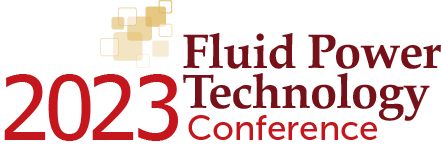Agenda
Expand All +
October 11, 2022
Pre-ConferenceOctober 12, 2022
October 13, 2022
 10:00 AM - 3:00 PM
10:00 AM - 3:00 PMHydraulics Basics Workshop
By Ken Dulinski, CFPAI, CFPJPP, CFPHS Department Head - Engineering, Mechatronics, Robotics, Macomb CollegeThis course, presented by Kenneth Dulinski, Macomb Community College, will provide an introduction to hydraulics, cover the principles of hydraulics, hydraulic symbology, fluids, actuators, valves and pumps. It will be broken down into the following:
1) Intro to Hydraulics
2) Principles of Hydraulics
3) Hydraulic Symbology
4) Hydraulic Fluids
5) Actuators
6) Pressure, Flow, and Directional Valves
7) Pumps 10:00 AM - 3:00 PM
10:00 AM - 3:00 PMAdvanced Hydraulics Workshop
By Thomas Blansett, CFPAI, CFPS Technical Director, International Fluid Power SocietyAdvanced hydraulics workshop covers IFPS Hydraulic Specialist certification topics
Have you attempted the Hydraulic Specialist certification exam and been unsuccessful or have you felt that some of the material was too difficult to understand, preventing you from attempting the test? New content was added a few years ago and those content areas may not be as familiar or as well-understood as the previous content.
If you answered yes to either of these questions, this workshop presented by Thomas Blansett, CFPAI, CFPS, Technical Director, International Fluid Power Society, will help. It’s designed to address the areas of the Hydraulic Specialist that are typically more challenging than others.
This advanced hydraulic training workshop will address topics found within the Hydraulic Specialist Study Manual that have been indicated by students as being more difficult than others. Specifically, it will address:
• Hydrostatic transmissions — theory of operation
• Hydrostatic steering principles
• Sizing prime mover using RMS method
• Unloading valves and unloading relief valves
• Pressure reducing valves and pressure reducing relieving valves
• PO Check Valve calculations
• DIN-style or Slip-in Cartridge valves principles of operation
• Regenerative circuits
• Sizing accumulators — isothermal and adiabatic
• Operation of proportional valves along with basic sizing principles
• Troubleshooting basics
All the content covered will be based on the most current version of the Hydraulic Specialist Study Manual.
- 7:30 AM
Registration
 9:00 AM - 10:00 AM
9:00 AM - 10:00 AMHow will electrification change the mobile hydraulic industry
By Peter Bleday Head of Autonomy, Danfoss Power Solutions, Michael Terzo CEO and Founder, Terzo Power SystemsElectrification of hydraulic systems is not a question of IF, it is a question of WHEN. As more mobile machinery manufacturers turn to electric systems to power their machinery, it is imperative that hydraulic technologies follow suit. Currently, less efficient hydraulics can't match the efficiency ratings of electric motors and batteries, but redesigned electrohydraulic actuator designs can meet the challenges. Learn from the innovators in this area, as they come together to discuss how the fluid industry is responding to these challenges.- In this session, Neil Mendes will offer insight into what fluid power users and manufacturers can expect from the global energy market as we deal the impacts of the pandemic and tumultuous worldwide events. He will highlight the following:
• Global Demand (Future) – All Sources including Energy Transition
• Global Production vs Consumption
• Global Storage and Spare Capacity
• Prices for Oil & Natural Gas
• Opportunities in this Market - 11:00 AM - 11:30 AM
Networking break
 11:30 AM - 12:30 PM
11:30 AM - 12:30 PMBuilding a Better Tie Rod Cylinder
By Josh Cosford General Manager, Higginson EquipmentAsk any fluid power professional what the maximum pressure rating for an NFPA tie-rod cylinder and they will tell you it is 3000 PSI. However, we don't have to accept this limitation, and with intelligent engineering, we can achieve 10,000 PSI or higher.- 11:30 AM - 12:30 PM
Next Generation of Burst Tester
This paper debates a required revision to existent methodology of Burst Pressure Test of hoses, tubes, fittings and other hydraulics vessels. Current systems based on air-driven pump, largely used by hydraulic hose manufactures and distributors, may no longer meet industry’s spec neither would stand more demanding testing. The NEXT GEN Burst Tester is an upgrade to current methodology by submitting samples to be tested with "CONTROLLED PRESSURE vs TIME" as exactly as established by hose specs and at same time providing accurate burst pressure results. This paper provides managers and users required tool to start a conversation inside their organizations on how appropriately run burst test. It is a valuable opportunity to enhance operators and environment safety while providing outstanding accurate and reliable testing results without any oversight when determining correct burst pressure of a hose and other hydraulic component. - 12:30 PM - 1:30 PM
Lunch on Exhibit Floor
 1:30 PM - 2:15 PM
1:30 PM - 2:15 PMHow can pressure intensifiers simplify and reduce cost in a hydraulic system
By Brian Wheeless Vice President of Sales, IC-Fluid PowerReview and understand what pressure intensifiers do and how to use them in hydraulic systems. Take a look at different applications and how they were used to reduce cost. The characteristics , advantages, and how they can benefit you in the design of high-pressure needs. 1:30 PM - 2:15 PM
1:30 PM - 2:15 PMAgricultural vehicles modelization and driving simulator with integrated ADAS solutions
By Céline Cabana Director North America | FD-GROUPS AmericaDevelopment of new machines or resolution of existing problems can be expensive and time consuming for industrials. Having the possibility to work on these subjects with a numerical model of the vehicle is a huge advantage which must be exploited. To have a complete model of the vehicle, a combination of software and way of communications between them are used in order to combine a complex Multiphysics model, including hydraulic (hydrostatic transmission, pipes, valves, …), mechanic (1D, 3D, tires, tires-soil contact, terrain …) and other necessary physics depending on the model (electric, …), a realistic environment with 3D views of the vehicle, statics and dynamics actors, captors (camera, Lidar, Radar, etc.), the possibility to control the vehicle with steering wheel and pedals and the use of a programming interface to couple the model with a calculator (the same as the one who is in the vehicle) integrating the complete command control of the machine. The following paper presents the method used to combine these three steps and how to use a complete model easily in order, for example, to study the vehicle behavior, test the relevance of the strategies of command control, or to implement autonomous tasks.- We use ten percent of our brain. Saturated fat causes heart attacks. Flow makes it go. These statements have one thing in common - they're straight out lies. We can't expect to lure the next generation of fluid power professionals by sounding off jingles they inherently know are wrong. Today is the day we bunk Flow Makes It Go.
 2:15 PM - 3:00 PM
2:15 PM - 3:00 PMPneumatic tips and tricks for circuit design considerations
By Robert J. Sheaf, Jr. C.F.P.E. Owner/CEO, CFC-Solar, Inc.In this session from Sheaf, the user will gain insight into pneumatic circuit design, as he covers:
• Soft (Slow) start valve uses
• Quick Exhaust valves and their tubing needs
• Time delays with and without volume chambers
• Multiple pressures of a single actuator
• Pressure reducing valves for sequencing
• Intensifiers- 3:00 PM - 3:30 PM
Break
 3:30 PM - 4:30 PM
3:30 PM - 4:30 PMChallenges in Workforce Development
By Donna Pollander, ACA Executive Director | International Fluid Power Society, Laura Thero M.Ed Associate Dean, Engineering Technology, Macomb Community College, Stephanie Scaccianoce VP, Workforce Development, National Fluid Power AssociationIt's no secret that the fluid power industry's demographics are rapidly changing, as a bulk of the industry begins to retire. And while we are seeing younger, talented individuals coming into the industry, there is worry about a brain drain as legacy leaders leave the workforce. To that end, several industry organizations, businesses and educational institutions are working to increase fluid power training and exposure at all levels, from school-age all the way through current employees. Join panelists from the National Fluid Power Association, Georgia Tech, NAHAD, FPDA and Festo didactic to learn how they are working to ensure the workforce of tomorrow meets the needs of the industry of tomorrow.- 4:30 PM - 6:00 PM
Reception on Exhibit Floor
- 8:00 AM - 9:00 AM
Breakfast on Exhibit Floor
 9:00 AM - 10:00 AM
9:00 AM - 10:00 AMIndustry 5.0 and Convergent Manufacturing for Next Generation Fluid Power Products
By Dr. Christopher Saldaña Associate Professor, Mechanical Engineering | Georgia TechAdvancements in the use and deployment of sensors, collaborative robots and artificial intelligence in manufacturing plants are transforming the capabilities of manufacturing systems. Simultaneously, convergent manufacturing platforms are emerging that seamlessly integrate new techniques such as additive manufacturing with conventional processing. These rapidly maturing capabilities enable the manufacture of new types of products with unique features such as embedded sensing, multi-functional surfaces, and multi-material interfaces, among others. This talk will discuss the availability and utility of these technologies on the manufacturing floor, and how they are being used to drive enhancements in product design. The presentation will also provide some insight into the direction that artificial intelligence is heading in manufacturing operations, and the types of opportunities and value propositions that they will enable in the very near future. These new areas will revolutionize manufacturing operations from the production floor to the global supply chain, and there is no end in sight in terms of the opportunities and benefits. 10:00 AM - 11:00 AM
10:00 AM - 11:00 AMWhy is filtration the most important aspect of your fluid power system design?
By Josh Cosford General Manager, Higginson EquipmentFilters are the unsung heroes of every fluid power system, protecting and conditioning while asking nothing in return. This presentation covers the essentials of filter design and selection, from ISO Codes to filter media. There is more to consider when selecting a hydraulic filter than most think, and the only thing on the line is, oh, your entire hydraulic system!
Essential concepts like filter efficiency, design and operation will be discussed so you can up your filtration game.- 11:00 AM - 11:30 AM
Networking Break
Slip-in logic valve circuits are used in demanding applications that require long-life, low leakage, and high flow. Hydraulic valve circuits can be packaged in several unique ways depending on the application and working environment in which they exist. The way the valve systems are housed makes the packages look different, even though they are operationally remarkably similar.
In this session, Sheaf will give an overview of hydraulic logic (slip-in) valve circuits, with in-depth discussion of the following:
• Pressure control,
• Flow control,
• And directional valves  11:30 AM - 12:30 PM
11:30 AM - 12:30 PMSolutions for Multiple Hydraulic Connections
By Mark DuVernay Business Development Manager, CEJNReady...Set…Connect! How Hydraulic Multi-Connectors Can Work for You.
CEJN, a leading manufacturer of quick connect coupling solutions, will share insights and ideas of how a hydraulic multi-coupling can add value for both the equipment/attachment manufacturer and its end customers.
As our hydraulic industry continues to evolve, equipment/attachment manufacturers are tasked with finding and creating additional value for their end customers. Often times this is accomplished by utilizing components that offer operator time savings, ease of operation use, and the reduction of human mistakes... especially in areas with which the end customer interacts (i.e. quick coupling connection between the machinery and attachments).
CEJN is a global company with manufacturing located in Skövde, Sweden, where we develop, manufacture and market quick-connect couplings and accessories within the fields of pneumatics, hydraulics, and fluids. 11:30 AM - 12:30 PM
11:30 AM - 12:30 PMLearn how custom/solution-specific designs can improve your industrial applications
By Steve Dellos Outside Sales Manager, DMICIn this presentation, attendees will learn about the many DMIC custom capabilities — ball valves, flow controls, SSW, subsea offering and more. Steven Dellos will highlight safety aspects of these custom solutions. DMIC specializes in custom solutions to provide high quality domestic low cost results to your industry applications. Our tech service group and engineers supply the expertise to solve your problems with 30+ years of experience. DMIC is U.S. quality, expertise and safety.- 12:30 PM - 1:30 PM
Lunch on Exhibit Floor
 1:30 PM - 2:30 PM
1:30 PM - 2:30 PMIoT is just a Feature: Defining ROI and delivering value through new services and solutions enabled by IoT
By Adam Livesay Co-Founder and CRO, Elevāt.IoTThrough several use case examples, Adam Livesay will highlight how using IoT will help increase efficiency and reliability of your machines.- 1:30 PM - 2:30 PM
Optimized pump designs
 2:30 PM - 3:30 PM
2:30 PM - 3:30 PMIs Amazon (and eCommerce) changing the dynamics of fluid power?
By Jeremy Drury President, DiscountHydraulicHose.comIn a post-COVID world, how we buy and our expectations on service and delivery have radically changed. As Amazon continues to disrupt industry after industry, how safe is the fluid power market and our traditional methods of doing business? Would you believe that Amazon now far outranks Google on where the majority of people search for products, including industrial parts? Customers now have more information at their digital fingertips than ever before, and distributors may be scrambling to keep up differentiated service values. Ecommerce vs. traditional distribution will come to a head in the 2020's.
Join Jeremy Drury as he explores who may come out on top, and how each side can prepare for the battle ahead. This presentation will seek to inform both customers and suppliers alike by exploring all of the new and advanced digital capabilities that come with buying online, and a few pitfalls as well. Jeremy has led companies on both sides of the fence and his final answer may surprise you.- 3:30 PM - 4:30 PM
Hydraulic System Schematic Reading Skills with Live Schematics
Making sense of the symbols and the interconnections on hydraulic system schematic diagrams can be challenging. Join Dyke for an interactive presentation that examines the brief and recent history of hydraulic symbol standards. He will use Live Schematics simulations to simplify the reading of mining machine and pulp mill hydraulic schematics. Bring your phone, tablet or laptop to the session to interact with the same systems used in the presentation and to receive a complimentary 90 day account on LunchBoxSessions.com
Fluid Power Network
Resources
Subscribe to Fluid Power World
Advertise with usFor registration or logistic questions, contact events@wtwhmedia.com
Sponsorship Opportunities
Ryan Ashdown
rashdown@wtwhmedia.com
216-316-6691


